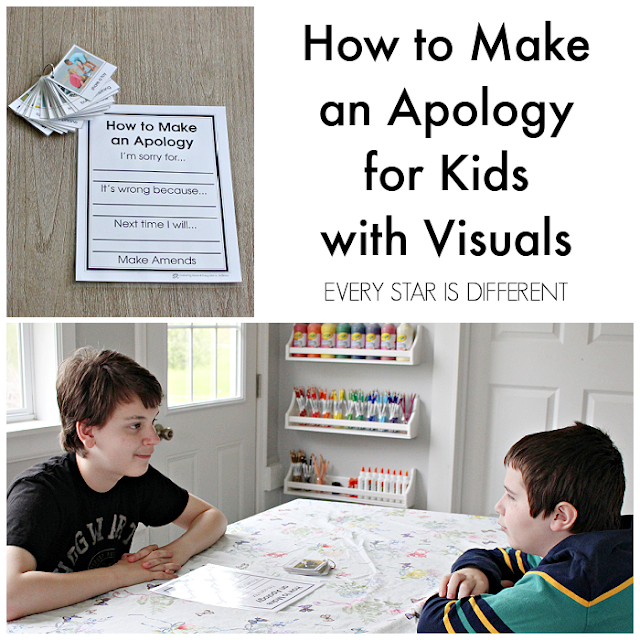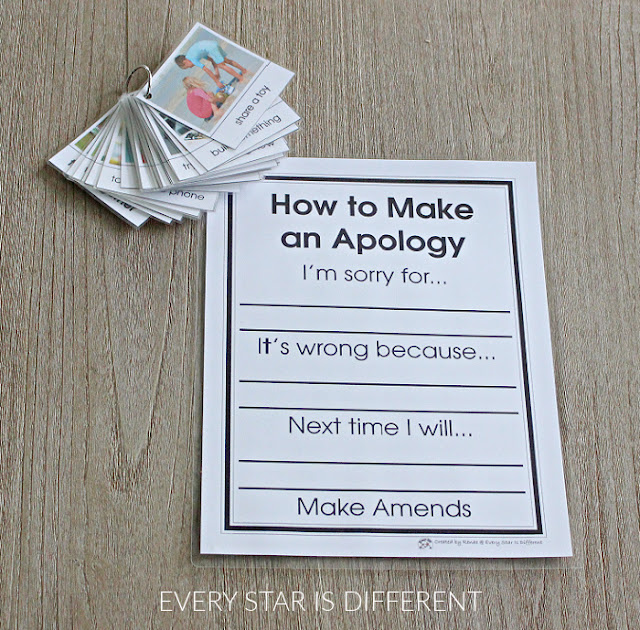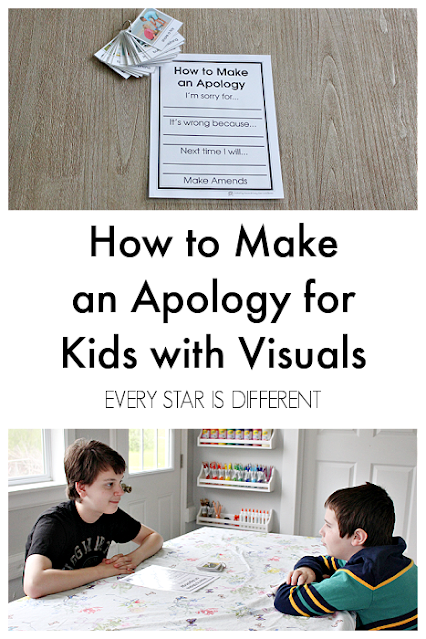How to Make an Apology for Kids with Visuals
How to Teach Neurodiverse and Neurotypical Children to Make an Apology
The first part of the resource I created is a "How to Make an Apology" cheat sheet. This guides the kids through the apology process in four simple steps.
The second resource is our "Amends Cards." These are incredibly helpful when completing the last step of the apology process.
So how does one make a sincere and complete apology? Here are the four steps we've taught our children.
4 Steps to Make an Apology
1. I'm sorry for...
The kids use the phrase, 'I'm sorry for..." and then fill in the blank with whatever they have done.
It's incredibly important to make sure there is a conversation between the caregiver and the child who needs to apologize before the child is expected to carry out the apology.
The adult needs to ensure that the child knows what he did wrong, and that he are able to communicate this to the person he hurt.
In our home, sometimes this includes practicing what is going to be said.
2. It's wrong because...
After a child apologizes, it's incredibly important that he understands why the behavior was wrong and be able to communicate that to the person that's been hurt.
Again, this step is usually practiced with an adult before a child faces a sibling or other person.
3. Next time I will...
The third step of the apology requires the child to plan out what he will do next time instead of the behavior that hurt someone else.
Here's an example:
"Next time I will use a kind and quiet voice, instead of yelling at you, when I am feeling upset."
The child may not be perfect at following through with this step, but it's incredibly important to work on it and to understand that things can be done a different way.
Having a plan set up before hand to address a behavior is often the best way to avoid future incidents, especially if it's communicated out loud and caregivers can provide support in carrying it out.
4. Make amends.
The final step of an apology is "showing" that one is actually sorry. This means putting forth the effort to make an amends.
At times this can be the hardest step for multiple reasons.
Thinking of an amends can be difficult, especially for those on the autism spectrum who may not understand what that even means.
Carrying out an amends can cause frustration, especially when ideas are bigger and more time consuming than anticipated, interrupting rituals and routines.
For these reasons we have created cards that give kid-friendly choices of how to show love to others. These cards provide a variety of options to ensure that every child can be successful at making amends.
In our home, these are called the "Amends Cards." The kids know to grab them when they are required to make an apology, finding a task card that they're comfortable with, and one that the person their making amends to may enjoy.
Eventually they'll be able to come up with ideas for making amends on their own, but for now, these work fabulously well.
These cards take the anxiety out of making amends for kids on the autism spectrum which helps so much!
Montessori-inspired Friendship Printable Pack
If you're wondering if this printable pack is worth it, be sure to check out our Physical Boundaries and Consent Activities for Kids. This post also includes resources and visuals from the same printable pack, explaining how we use them.
How to Teach Children with Reactive Attachment Disorder How to Make an Apology
Practice through Role Play Situations
As we practice new social skills in calm situations, the kids are much more likely to understand them and show mastery in them.
Bulldozer and Dinomite especially liked role playing the apology process, coming up with scenarios in which they had to apologize. You can tell this from the picture above. Their expressions crack me up as both were trying really hard not to break character and laugh.
Princess and Sunshine were able to demonstrate to all that they were able to apologize successfully without behaviors during the practice scenarios. This was incredibly important for siblings to see.
Once the role play was complete, the resources were put on the refrigerator for easy access and reminders.

















Love this and appreciate the resource! I also love the way you explained loving someone from a distance while not putting yourself at risk. Makes it more concrete for our concrete thinkers.
ReplyDeleteI try not to force apologies--but amends are different. I hated as a child being forced to say I was sorry when I wasn't actually sorry. It was dishonest. However, addressing natural consequences and making up for a wrong still needs to be done whether it is liked or not.
Thanks again for the great resource!